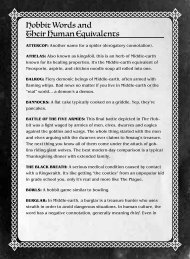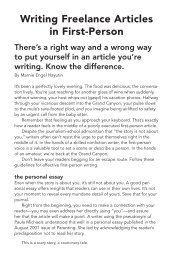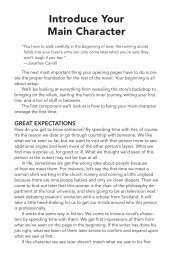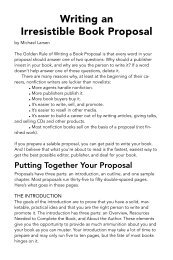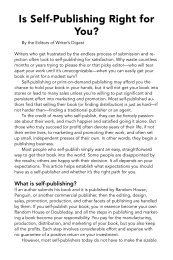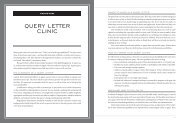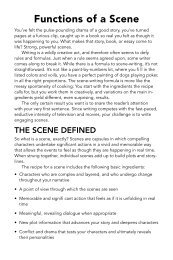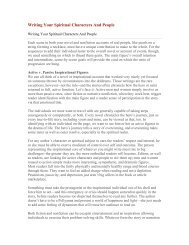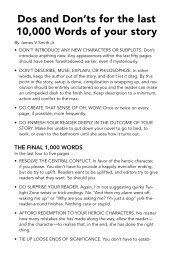How to Raise the Emotional Stakes - Writer's Digest
How to Raise the Emotional Stakes - Writer's Digest
How to Raise the Emotional Stakes - Writer's Digest
You also want an ePaper? Increase the reach of your titles
YUMPU automatically turns print PDFs into web optimized ePapers that Google loves.
<strong>How</strong> <strong>to</strong> <strong>Raise</strong> <strong>the</strong> <strong>Emotional</strong><br />
<strong>Stakes</strong><br />
by Orson Scott Card<br />
Reading a s<strong>to</strong>ry is not a passive process. While a reader may seem <strong>to</strong> be<br />
sitting still, slowly turning pages, in his own mind he is going through<br />
a great many emotions. Underlying all of <strong>the</strong>m is a strong tension. The<br />
stronger it is, <strong>the</strong> more <strong>the</strong> reader concentrates on finding out what happens<br />
next, <strong>the</strong> more attention he pays.<br />
The amount of tension <strong>the</strong> reader feels depends partly on her emotional<br />
state, her imagination, her ability as a reader. But <strong>the</strong> strength of<br />
<strong>the</strong> s<strong>to</strong>ry’s tension also depends on choices you make. Some of <strong>the</strong>se<br />
choices have <strong>to</strong> do with <strong>the</strong> s<strong>to</strong>ry’s structure and o<strong>the</strong>rs are simply outside<br />
<strong>the</strong> scope of this book. <strong>How</strong>ever, <strong>the</strong>re are several things you can do<br />
with characters <strong>to</strong> raise <strong>the</strong> readers’ emotional stake in <strong>the</strong> s<strong>to</strong>ry, make<br />
<strong>the</strong>m more emotionally involved in what’s happening, make <strong>the</strong>m care<br />
more about <strong>the</strong> outcome.<br />
SUFFERING<br />
Pain is a sword with two edges. The character who suffers pain and <strong>the</strong><br />
character who inflicts it are both made more memorable and more important.<br />
Pain can be ei<strong>the</strong>r physical or emotional. Great grief and great physical<br />
agony, well presented in <strong>the</strong> tale, can greatly increase <strong>the</strong> reader’s<br />
emotional involvement. Remember, though, that you aren’t using grief <strong>to</strong><br />
make <strong>the</strong> reader grieve any more than you’re using physical pain <strong>to</strong> make<br />
<strong>the</strong> reader bleed. Readers don’t necessarily feel what <strong>the</strong> characters are<br />
feeling—when <strong>the</strong> villain cries out in his agony of defeat, <strong>the</strong> reader may<br />
be cheering inside. But <strong>the</strong> intensity of <strong>the</strong> characters’ feeling, as long as<br />
it remains believable and bearable, will greatly intensify <strong>the</strong> reader’s feelings—whatever<br />
<strong>the</strong>y are.<br />
Of course, not all pain is alike. A cut finger doesn’t magnify a character<br />
very much. Ghastly physical <strong>to</strong>rture can become unbearable <strong>to</strong> imagine,<br />
so that <strong>the</strong> reader refuses <strong>to</strong> remain engaged with <strong>the</strong> s<strong>to</strong>ry and you<br />
lose him completely. The most powerful uses of physical and emotional<br />
pain are somewhere between <strong>the</strong> trivial and <strong>the</strong> unbearable.<br />
In Stephen King’s The Dead Zone, <strong>the</strong> main character suffers terribly:<br />
A traffic accident puts him in a coma for many years; he loses his career,
<strong>the</strong> woman he loves, and many years of his life. Fur<strong>the</strong>rmore, when he<br />
finally recovers, he continues <strong>to</strong> suffer in body and soul. And with each<br />
twinge of pain and grief, <strong>the</strong> reader’s emotional involvement in <strong>the</strong> s<strong>to</strong>ry<br />
becomes more intense.<br />
Notice that his pain is both physical and emotional. The loss of a<br />
loved one can weigh as heavily in <strong>the</strong> mind of <strong>the</strong> audience as <strong>the</strong> loss of<br />
a limb. <strong>How</strong>ever, physical pain is much easier <strong>to</strong> use because it doesn’t<br />
have <strong>to</strong> be prepared for. If a character is <strong>to</strong>rtured, as in King’s novel<br />
Misery, <strong>the</strong> audience will wince in sympa<strong>the</strong>tic agony even if <strong>the</strong>y don’t<br />
know <strong>the</strong> character very well—even if <strong>the</strong>y have never seen <strong>the</strong> character<br />
before. <strong>Emotional</strong> loss does not come so easily. In The Dead Zone, King<br />
devoted several pages <strong>to</strong> creating a warm, valuable love relationship between<br />
<strong>the</strong> main character and <strong>the</strong> woman he loves. It is at a vital moment<br />
in <strong>the</strong>ir relationship that he has his terrible traffic accident. Now when<br />
he discovers that she married someone else during his coma, <strong>the</strong> readers<br />
know how much he loved her, and so <strong>the</strong> pain of losing her actually<br />
outweighs <strong>the</strong> physical pain he suffered.<br />
Suffering loses effectiveness with repetition. The first time a character<br />
is hit in <strong>the</strong> head, <strong>the</strong> pain raises her importance; <strong>the</strong> third or fourth time,<br />
<strong>the</strong> character becomes comic, and her pain is a joke. Likewise, <strong>the</strong> first<br />
time you mention a character’s grief, it raises his stature and makes <strong>the</strong><br />
reader more emotionally involved. But if you keep harping on <strong>the</strong> character’s<br />
suffering, <strong>the</strong> reader begins <strong>to</strong> feel that <strong>the</strong> character is whining, and<br />
<strong>the</strong> reader’s emotional involvement decreases.<br />
You can see this with audience reactions <strong>to</strong> slasher movies—those<br />
horror flicks in which <strong>the</strong> special effects department keeps coming up<br />
with cool new ways <strong>to</strong> dismember <strong>the</strong> characters. The hideous murders in<br />
<strong>the</strong>se movies were originally devised <strong>to</strong> jack up <strong>the</strong> audience’s emotions,<br />
higher and higher with each death. Ra<strong>the</strong>r sooner than <strong>the</strong>y expected,<br />
however, many in <strong>the</strong> audience s<strong>to</strong>pped being horrified and began <strong>to</strong><br />
laugh. This is not really a sign of <strong>the</strong> audience’s moral decay or inability<br />
<strong>to</strong> empathize; it’s simply that an audience reaches a point when fictional<br />
pain is <strong>to</strong>o difficult <strong>to</strong> bear. When pain or grief become unbearable in<br />
real life, human beings often develop fictions <strong>to</strong> cope with it—we call it<br />
insanity. When pain or grief become unbearable in fiction, readers simply<br />
disengage from <strong>the</strong> s<strong>to</strong>ry and ei<strong>the</strong>r abandon <strong>the</strong> tale or laugh at it.<br />
Does this mean that pain is a sharply limited character device No—<br />
it is almost unlimited in its potential. But you must remember that you<br />
increase <strong>the</strong> power of suffering, not by describing <strong>the</strong> injury or loss in<br />
greater detail, but ra<strong>the</strong>r by showing more of its causes and effect. Blood<br />
and gore eventually make <strong>the</strong> audience gag; sobbing and moaning even-
tually earn <strong>the</strong> audience’s laughter or contempt. On <strong>the</strong> o<strong>the</strong>r hand, if<br />
you make us understand how intensely <strong>the</strong> character loved before losing<br />
<strong>the</strong> loved one or trusted before being betrayed, <strong>the</strong>n his grief will have<br />
far greater power, even if you show it with great economy. If you show a<br />
character coping with her pain or grief, refusing <strong>to</strong> succumb <strong>to</strong> it, <strong>the</strong>n<br />
readers will wince or weep for her. Ano<strong>the</strong>r rule of thumb: If your characters<br />
cry, your readers won’t have <strong>to</strong>; if your characters have good reason<br />
<strong>to</strong> cry, and don’t, your readers will do <strong>the</strong> weeping.<br />
SACRIFICE<br />
Pain or grief also increase a reader’s intensity in proportion <strong>to</strong> <strong>the</strong> character’s<br />
degree of choice. Pete has broken his leg on a hike, and Nora<br />
has <strong>to</strong> set it for him. That scene will be painful and will certainly magnify<br />
both characters as <strong>the</strong>y cause and suffer pain. But Pete’s pain will be far<br />
more powerful if he is alone and has <strong>to</strong> set <strong>the</strong> leg himself. As he ties a<br />
rope <strong>to</strong> his ankle, passes it around a tree trunk, braces his good leg and<br />
pulls on <strong>the</strong> end of <strong>the</strong> rope, <strong>the</strong> agony which he inflicts on himself will<br />
make <strong>the</strong> scene utterly unforgettable, even if we never see his face, even<br />
if his agony is never described at all. This works with emotional suffering<br />
as well. The climax of <strong>the</strong> movie Broadcast News comes when Holly<br />
Hunter’s character is forced <strong>to</strong> choose between her desperate passion<br />
for William Hurt’s charming but shallow character and her integrity as a<br />
journalist, which up <strong>to</strong> now has been <strong>the</strong> foundation of her whole life.<br />
When we see her give up her lover in order <strong>to</strong> preserve her integrity, our<br />
emotions are far more intense than <strong>the</strong>y would have been if she had lost<br />
him under circumstances beyond her control. Self-chosen suffering for<br />
<strong>the</strong> sake of a greater good—sacrifice, in o<strong>the</strong>r words—is far more intense<br />
than pain alone.<br />
When one character willingly inflicts pain on ano<strong>the</strong>r, <strong>the</strong> <strong>to</strong>rturer<br />
becomes as important, in our fear and loathing, as <strong>the</strong> victim becomes in<br />
our sympathy. This is <strong>the</strong> o<strong>the</strong>r side of <strong>the</strong> coin of sacrifice. If a character<br />
is driving a car and accidentally hits and injures a child, it has a powerful<br />
effect. But if a character deliberately chooses <strong>to</strong> cause someone else<br />
pain, <strong>the</strong> effect is even stronger. The audience may hate <strong>the</strong> character,<br />
but <strong>the</strong> intensity of feeling is much stronger than when <strong>the</strong> character<br />
caused pain without meaning <strong>to</strong>. It’s no accident that <strong>the</strong> most memorable<br />
character in many s<strong>to</strong>ries is <strong>the</strong> sadistic villain; <strong>the</strong> hero often seems<br />
bland and forgettable by comparison.<br />
JEOPARDY<br />
Jeopardy is anticipated pain or loss. As anyone who has been <strong>to</strong> a den-
tist knows, <strong>the</strong> anticipation of pain is often more potent than its actuality.<br />
When a character is threatened with something bad, <strong>the</strong> audience au<strong>to</strong>matically<br />
focuses its attention on him. The more helpless <strong>the</strong> character<br />
and <strong>the</strong> more terrible <strong>the</strong> danger, <strong>the</strong> more importance <strong>the</strong> audience will<br />
attach <strong>to</strong> <strong>the</strong> character.<br />
That is why children in danger are such powerful characters; so<br />
powerful, in fact, that some films become unbearable <strong>to</strong> watch. The film<br />
Poltergeist was strong stuff for that reason. Some horror-movie buffs<br />
pooh-poohed <strong>the</strong> film because “nothing really happened”; nobody got<br />
gruesomely killed. What <strong>the</strong>y didn’t realize is that a dozen creative slashings<br />
of teenage kids in a spatter movie won’t equal <strong>the</strong> power of a single<br />
scene in which children are being dragged <strong>to</strong>ward terrible death while<br />
<strong>the</strong>ir mo<strong>the</strong>r struggles vainly <strong>to</strong> try <strong>to</strong> reach <strong>the</strong>m in time.<br />
The films Alien and Aliens crossed <strong>the</strong> line for me. The jeopardy simply<br />
became unbearable. I had <strong>to</strong> leave <strong>the</strong> <strong>the</strong>ater. I have since watched<br />
both films in <strong>the</strong>ir entirety—but never all at once. I could only watch<br />
<strong>the</strong>m in sections, flipping cable channels now and <strong>the</strong>n <strong>to</strong> break <strong>the</strong> tension<br />
caused by <strong>the</strong> unrelenting jeopardy.<br />
The greater <strong>the</strong> jeopardy, <strong>the</strong> stronger <strong>the</strong> pain when <strong>the</strong> dreaded<br />
event actually occurs. In <strong>the</strong> TV movie The Dollmaker, I did not realize<br />
how powerfully <strong>the</strong> jeopardy had affected me until it was <strong>to</strong>o late. Perhaps<br />
before I had children I could have borne it, but I have children now,<br />
and when <strong>the</strong> mo<strong>the</strong>r runs screaming <strong>to</strong> try <strong>to</strong> snatch up her little girl<br />
before her legs are run over by a moving train, <strong>the</strong> tension in me built <strong>to</strong><br />
a point higher than I have ever experienced in a s<strong>to</strong>ry. When <strong>the</strong> wheels<br />
finally reach <strong>the</strong> girl before her mo<strong>the</strong>r does, <strong>the</strong> girl’s pain, combined<br />
with <strong>the</strong> climactic release of <strong>the</strong> exquisite jeopardy, pushed me over <strong>the</strong><br />
edge. The first time I saw <strong>the</strong> film I had <strong>to</strong> turn off <strong>the</strong> television and<br />
weep. I couldn’t get control of myself for fifteen minutes.<br />
The writer had set up this jeopardy <strong>to</strong> be as powerful as it could<br />
possibly be. The little girl and <strong>the</strong> mo<strong>the</strong>r had already suffered so much<br />
emotional pain in <strong>the</strong> film that <strong>the</strong> audience already cared deeply about<br />
<strong>the</strong>m both. And <strong>the</strong> reason <strong>the</strong> girl was off by herself was a painful<br />
emotional confrontation. So <strong>the</strong> audience’s stake in <strong>the</strong>se characters was<br />
already strong.<br />
As <strong>the</strong> jeopardy develops, <strong>the</strong> girl is absolutely helpless—she has no<br />
idea <strong>the</strong> train is about <strong>to</strong> move. The mo<strong>the</strong>r is powerless <strong>to</strong> rescue her—<br />
how can she s<strong>to</strong>p a train <strong>How</strong> can she scream louder than <strong>the</strong> roaring<br />
of <strong>the</strong> engines And <strong>the</strong> power of <strong>the</strong> train is like <strong>the</strong> fist of God, it is so<br />
irresistible, so uncompromising.<br />
As a result, during <strong>the</strong> seconds—it feels like half an hour—when <strong>the</strong>
mo<strong>the</strong>r is struggling <strong>to</strong> get in<strong>to</strong> <strong>the</strong> train yard, racing <strong>to</strong> try <strong>to</strong> reach her<br />
daughter, <strong>the</strong> jeopardy made <strong>the</strong> characters more important <strong>to</strong> me, in<br />
those few moments, than any characters have ever been in my experience<br />
of reading and seeing s<strong>to</strong>ries. I could not bear <strong>to</strong> watch that scene<br />
again. I don’t have <strong>to</strong>. I can relive every moment of it in my memory.<br />
This particular example is more powerful than most jeopardy situations,<br />
of course, but it does show how jeopardy works. Jeopardy magnifies<br />
<strong>the</strong> stalker, <strong>the</strong> savior, and <strong>the</strong> prey, just as pain and sacrifice magnify<br />
sufferer and <strong>to</strong>rmen<strong>to</strong>r alike.<br />
Pain and jeopardy work hand in hand, <strong>to</strong>o. In Stephen King’s Misery,<br />
<strong>the</strong> hero is already in great pain from an au<strong>to</strong>mobile accident, but he is<br />
in danger of even worse suffering from <strong>the</strong> insane woman who holds him<br />
incommunicado and drugged <strong>to</strong> <strong>the</strong> gills in her remote mountain home.<br />
The danger of greater pain is constant, as she regulates him by withholding<br />
drugs. But <strong>the</strong>n comes <strong>the</strong> terrible moment when she actually maims<br />
him, cutting off first one part of his body, <strong>the</strong>n ano<strong>the</strong>r. It makes <strong>the</strong><br />
jeopardy all <strong>the</strong> more terrible, <strong>to</strong> know absolutely that she means <strong>to</strong> carry<br />
out her threats.<br />
It’s important <strong>to</strong> remember that jeopardy only works <strong>to</strong> increase <strong>the</strong><br />
audience’s tension if <strong>the</strong> audience believes that <strong>the</strong> dreaded event might<br />
actually happen. In old-fashioned melodramas, <strong>the</strong> jeopardy was often<br />
grotesque—<strong>the</strong> hero was tied <strong>to</strong> a log heading in<strong>to</strong> <strong>the</strong> sawmill; <strong>the</strong><br />
heroine was bound <strong>to</strong> <strong>the</strong> railroad tracks as <strong>the</strong> train approached. But <strong>the</strong><br />
audience eventually realized that <strong>the</strong>re was no chance (in those days) that<br />
<strong>the</strong> s<strong>to</strong>ryteller would ever allow <strong>the</strong> hero <strong>to</strong> be cut <strong>to</strong> ribbons by <strong>the</strong> saw,<br />
or <strong>the</strong> heroine <strong>to</strong> be spattered along <strong>the</strong> tracks by <strong>the</strong> train. Contemporary<br />
standards of decorum simply did not allow such things <strong>to</strong> be shown<br />
in a s<strong>to</strong>ry.<br />
Writers of melodrama, aware that grotesque jeopardy had finally<br />
become unbelievable—and <strong>the</strong>refore laughable—switched tactics.<br />
Instead of trying <strong>to</strong> find ever-more-horrible threats, <strong>the</strong>y used very simple<br />
threats, but <strong>the</strong>y made <strong>the</strong>m come true. The first time a writer had <strong>the</strong><br />
villain jam a burning cigarette in<strong>to</strong> <strong>the</strong> heroine’s hand, <strong>the</strong> audience<br />
gasped and a threshold was crossed. The villain had proved that he not<br />
only could cause pain, he would. His next threat was credible again, and<br />
because <strong>the</strong> audience believed, jeopardy was again a powerful <strong>to</strong>ol for<br />
creating tension.<br />
SEXUAL TENSION<br />
Sexual tension is related <strong>to</strong> jeopardy. In fact, you could call it “jeopardy<br />
of sex,” except that presumably your characters desire sex ra<strong>the</strong>r more
than <strong>the</strong>y desire pain. Sexual tension is so vital <strong>to</strong> so many s<strong>to</strong>ries that<br />
<strong>the</strong> term romance is now generally used <strong>to</strong> refer <strong>to</strong> s<strong>to</strong>ries that are about<br />
sexual tension. It crosses all cultural boundaries. When a man and woman<br />
meet in a s<strong>to</strong>ry, we assume at least some degree of sexual possibility.<br />
If <strong>the</strong> two characters immediately become important <strong>to</strong> each o<strong>the</strong>r, <strong>the</strong><br />
sexual tension increases—especially if <strong>the</strong>y become important in a negative<br />
sense. Rivalry, contempt, anger—none of <strong>the</strong>m make us doubt for<br />
a moment that <strong>the</strong> sexual possibility is real, and <strong>the</strong> more intense <strong>the</strong>se<br />
negative feelings are, <strong>the</strong> more sexual tension <strong>the</strong>re is.<br />
<strong>How</strong>ever, for sexual tension <strong>to</strong> make two characters more important,<br />
<strong>the</strong> audience must recognize <strong>the</strong>m as meeting <strong>the</strong> general social standards<br />
of sexual attractiveness. When Clark Gable and Claudette Colbert<br />
met in It Happened One Night, <strong>the</strong> audience instantly recognized <strong>the</strong>m<br />
as suitable sex objects.<br />
This does not mean that all participants in sexual tension have <strong>to</strong> be<br />
physically beautiful, though that is certainly <strong>the</strong> easiest way. If you have<br />
made an unbeautiful character important <strong>to</strong> us for o<strong>the</strong>r reasons, we will<br />
regard him as sexually attractive despite a lack of physical beauty, and<br />
sexual tension will work for him. John Merrick’s devotion <strong>to</strong> <strong>the</strong> actress<br />
played by Anne Bancroft in The Elephant Man was charged with sexual<br />
energy, even though ac<strong>to</strong>r John Hurt’s makeup was repulsive.<br />
On a milder level, <strong>the</strong> television series L. A. Law brought off a similar<br />
effect between <strong>the</strong> characters played by Jill Eikenberry and Michael<br />
Tucker. Tucker is short and pudgy, with a receding hairline, playing meek<br />
tax lawyer Stuart Markowitz; Eikenberry is a tall, attractive, compelling<br />
woman playing high-powered trial lawyer Ann Kelsey. The audience did<br />
not see any sexual possibility between <strong>the</strong>m. In fact, when a drunken<br />
Kelsey proposed a night of unwedded bliss <strong>to</strong> Markowitz at a party, it<br />
was comic because it was so unexpected—so odd. Gradually, however,<br />
<strong>the</strong> sexual tension grew as our sympathy with Markowitz grew. We recognized<br />
that he was a good man; we identified with him and his attraction<br />
<strong>to</strong> Kelsey; and finally we felt a strong desire <strong>to</strong> bring <strong>the</strong>m <strong>to</strong>ge<strong>the</strong>r.<br />
Sexual tension intensifies <strong>the</strong> audience’s involvement with all characters<br />
involved. <strong>How</strong>ever, as several TV series have discovered <strong>to</strong> <strong>the</strong>ir<br />
sorrow, tension dissipates when characters come <strong>to</strong>ge<strong>the</strong>r in sexual harmony.<br />
It isn’t like violence, which establishes <strong>the</strong> villain’s credibility and<br />
makes <strong>the</strong> next round of jeopardy even more powerful. Instead, sexual<br />
fulfillment has <strong>the</strong> same effect on sexual tension that <strong>the</strong> death of <strong>the</strong> victim<br />
has on jeopardy. For that character, at least, <strong>the</strong> tension is over. The<br />
writers of Cheers quickly realized <strong>the</strong>ir mistake and split Sam and Diane;<br />
<strong>the</strong> writers of Moonlighting never gave David and Maddie a moment <strong>to</strong>
enjoy sexual harmony before putting <strong>the</strong>m back in hopeless, hilarious<br />
conflict—and <strong>the</strong> sexual tension remained high, at least for a while.<br />
SIGNS AND PORTENTS<br />
Ano<strong>the</strong>r way <strong>to</strong> increase <strong>the</strong> readers’ intensity is <strong>to</strong> connect a character<br />
with <strong>the</strong> world around her, so that her fate is seen <strong>to</strong> have much wider<br />
consequences than her private loss or gain. King Lear’s climactic moment<br />
is linked with a s<strong>to</strong>rm, and though we take his attempt <strong>to</strong> command<br />
<strong>the</strong> wind (“Blow, winds! Crack your cheeks!”) as a sign of madness, <strong>the</strong><br />
fact is that <strong>the</strong> wind is blowing, <strong>the</strong> s<strong>to</strong>rm is raging, and we receive <strong>the</strong><br />
subliminal message that what happens <strong>to</strong> Lear has cosmic implications.<br />
His daughters’ betrayal of <strong>the</strong>ir oaths <strong>to</strong> him, <strong>the</strong>ir plotted patricide, is<br />
more than a private tragedy—it is a disorder in <strong>the</strong> world, which must be<br />
resolved before <strong>the</strong> universe can again be at peace.<br />
In tragedy and high romance, <strong>the</strong> connection between a character<br />
and <strong>the</strong> world around him can be quite open. The ark of <strong>the</strong> covenant in<br />
Raiders of <strong>the</strong> Lost Ark is more than a secret weapon—its opening represents<br />
<strong>the</strong> unleashing of <strong>the</strong> power of God. When <strong>the</strong> villain opens it, <strong>the</strong><br />
s<strong>to</strong>ryteller makes sure we understand that it isn’t a mere boobytrap that<br />
kills him. The ark isn’t opened until it is brought <strong>to</strong> a special holy place,<br />
and when <strong>the</strong> lid comes off, we see spirits spiraling around, terrible winds<br />
and fire, finally culminating in a whirlwind that disturbs <strong>the</strong> very heavens.<br />
Likewise, Oedipus’s sins cause a famine, which doesn’t end until he pays<br />
<strong>the</strong> price; s<strong>to</strong>rms rage across <strong>the</strong> moors in Wu<strong>the</strong>ring Heights exactly<br />
when <strong>the</strong> mood of <strong>the</strong> characters is most turbulent.<br />
Even when you’re trying for more subtlety, however, signs and portents<br />
are still vital <strong>to</strong>ols in drawing your reader more intensely in<strong>to</strong> <strong>the</strong><br />
tale. You simply disguise <strong>the</strong> cosmic connections a little better. The great<br />
s<strong>to</strong>rm becomes a gentle drizzle; <strong>the</strong> flaming sky becomes a sweltering<br />
day; <strong>the</strong> roll of thunder becomes a distant siren in <strong>the</strong> city; <strong>the</strong> famine<br />
becomes <strong>the</strong> wilting of a flower in <strong>the</strong> window. The connection between<br />
character and cosmos will still be <strong>the</strong>re, and, often without consciously<br />
noticing <strong>the</strong> portents, <strong>the</strong> audience will become more intensely involved<br />
with what <strong>the</strong> character does.<br />
You can’t control everything <strong>the</strong> reader feels, and no two members of<br />
your audience will ever be emotionally involved in your s<strong>to</strong>ry exactly <strong>to</strong><br />
<strong>the</strong> same degree. Still, <strong>the</strong>re are some things you can control, and if you<br />
use <strong>the</strong>m deftly, without letting <strong>the</strong>m get out of hand, you can lead most<br />
of your audience <strong>to</strong> intense emotional involvement with your characters.<br />
The audience won’t necessarily like <strong>the</strong> characters, but <strong>the</strong>y certainly<br />
won’t be indifferent <strong>to</strong> <strong>the</strong>m.



